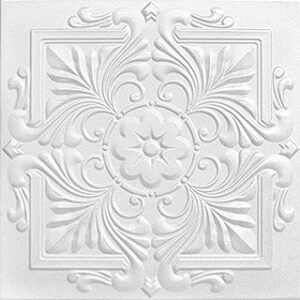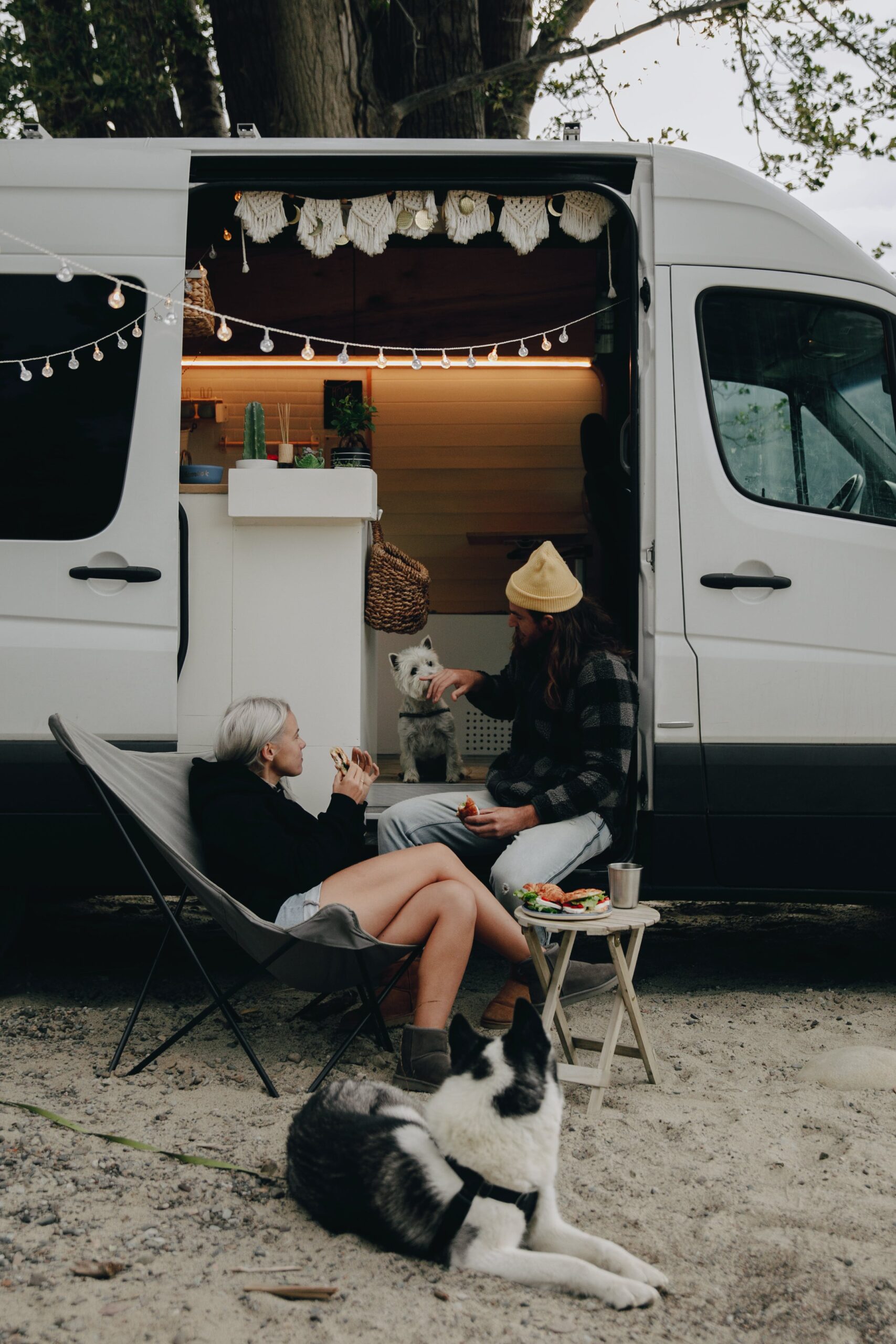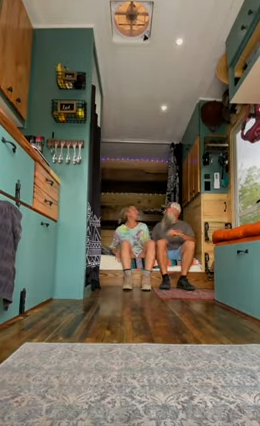There are a lot of videos of van builds featuring cargo/work and passenger vans. These are the most popular vehicles for nomad living because they offer more living space and headroom than a passenger vehicle, and while they rival small camper trailers in size, they are easier to drive than a trailer and can remain completely stealth. They’re also cheaper than your average motorhome, provided you can do most or all of the buildout yourself.
This has to be the most space-efficient van build that I have ever seen. He also has a lot of ingenious hacks I haven’t seen elsewhere, like magnets holding on the decorative wall panels (in case you’re afraid to drill into the walls) and puzzle-piece tiles that I’ve never seen before. This is also the only bunkbed setup I’ve seen. He said it’s so he and his wife—both of whom have to get up to potty in the middle of the night—don’t have to crawl over each other to get out of bed, but this idea also works well if you’re hitting the road with a kiddo, a sibling, or a friend. The only thing I would do differently is change the toilet cabinet into a wet bath so that everything I need is in my van.
This is a small cargo van that’s home to a young, solo female traveler. She originally started living in her car in order to pay down her debt, but having completed that goal, she decided to continue to live out of her vehicle for a while to save up money. She started out in a car, but after a small accident that resulted in totaling the car, she upgraded to this small van for a bit more space. She has a fairly typical design with a homemade futon and a decent-sized kitchen, but what I really liked and what is unique is how she used hooks to hang up baskets for vertical space (in lieu of overhead cabinets). This makes the build a bit easier to do and, as she points out, makes it feel more open and less closed in.
This British mum alternates between living in a van and living on a boat with her toddler to save money on rent. She was a roadie for a time, so she was used to living out of a van and traveling a lot before she had a baby. She said she’s always been fascinated by campers (caravans, in British parlance), so it seemed natural for her to live in one, even with a baby. For her son, the outdoors is his playroom, and he seems to love it.
This is a passenger van build with a lot of room—comparable to a small camper. This build did have a lot of carpentry work required, but the owner admits he knew very little about electrical, so he has everything wired so he can just plug it into his solar generator, and it’s conveniently located so he can charge it using his van’s battery (although he also has the option of charging it using portable solar panels or using shore power).
This is a pretty van build, but the coolest part is the closet that swings out to allow access to the bathroom. I have seen other people store clothes in their shower using a café rod, but taking a shower means taking all of your clothes out. (Even using the toilet means sitting in the jungle of clothes.) This innovative design allows the space to be used as a closet while easily getting it out of the way so the bathroom can be used.
If you’re not vibing the van or trailer builds we’ve looked at so far, and you wish they felt more homey, take a look at this van, which has been made to look like a tiny British/old European house or some sort of Hobbit hole on wheels.
If you prefer the more modern European look of white and sleek, check out this high-end build that looks like some sort of first-class suite on an airplane or train. It features a full-size murphy bed that serves as a couch/dinette seating during the day, as well as a decent-size wet bath.
This van sort of combines the two previous ones, being light and airy, but with little touches that give it a cottage feel. It looks like a place where you would be happy to spend a rainy day reading a book, rather than feeling like you’re trapped in a small, dark space. It has a unique kitchen design, a hammock chair, and a small dog house. She also reveals her secret for keeping decorative items in place on the counters while traveling.
This is a large van with the usual: kitchen, dinette, full-size bed, shower and toilet. Two features that are unique is that the doorway has been left wide enough that it can still be used for hauling, and one of the dinette seats is a second-row passenger seat, which means 3 people can ride in the van. So, if you need a vehicle you can live in and do a bit of work out of–even haul a helper with you–this can give you some ideas for a hybrid live/work van. Also of interest is his mobile hotspot that he uses for gaming.
This standard-size, fully-stealth cargo van features a wood burning stove and all the equipment needed for recording videos and gaming. The bed runs along the wall, instead of across the back, and this would be a better option for you if you’re tall, like the creator. The cost of the van and everything required for the build out was $10,000, so you can have a place to live and a vehicle for commuting to work or traveling for the cost of a used car.
This beautiful camper van was built in a small, high-top Japanese van and has a cabin-in-the-woods theme. It features a wet bath and some innovative ideas, like using epoxy on wood to make granite-look countertops (saving money and weight) and two pop-up counters for more prep area. He has the bed across the back, but because it’s really too sort for him, he has a pull-out into the kitchen area that allows it to be more like a full-length bed. But when it’s not pulled-out, this area can serve as a place to curl up and nap, or it can be extra seating, and it still has the under-bed garage area that this cross-ways layout allows. (If you didn’t like how narrow the pull out is, you could eliminate the wall between the bed and the sink and get a camper faucet that’s made to fold down into the bowl of the sink so you could make the pull-out the full width of the van.)
This is a very cute but small transit van for a single person and dog, featuring a couch that turns into a twin bed and both an interior and exterior kitchen space. If you’re intimidated by driving (or parking) a larger van, this one is about the size of a personal vehicle, just with a bit more headroom. This also might give you design ideas if you are not interested in having an onboard bathroom, as it only has separate, pop-up camp versions of both.
This video shows the creation of this van conversion in a good deal of detail. The man who made it has a very high level of carpentry, so this is not the sort of thing you will be able to achieve as a beginner. But you can still get a lot of ideas on how to do things, like run wires for a rooftop solar panel, and the build is attractive and looks very spacious. He has videos of other builds and promises more detailed how-to build videos in the future, so this will probably be a valuable resource for learning more.
This custom-built rig, in the style of a Victorian séance parlor, could not have come cheap, but there are a lot of things that could be copied fairly cheaply by the DIYer. For one, it’s proof you don’t have to look like you’re living in a van while living in a van. Decide on your style/theme and stick with it. Max it out. The more you do it, the more like a wonderful little dollhouse (and less like a vehicle) it will look.
Secondly, I think this is the first van I’ve seen that’s used wallpaper in the interior. While this needs to be applied to plywood panels, it’s still an easier option than cutting a lot of shiplap boards. (Make sure, however, that you spend the money for a thick, high-quality wallpaper. You likely only need one roll anyway and it will resist tearing and scratching better than a cheaper option. You may also want to consider using wallpaper glue instead of just what comes on it because it will be exposed to larger temperature swings and more humid conditions than a typical house, so glue failure will be more of a concern.)


Her ceiling is probably plastic, but there are also foam tiles that you can buy and paint to look like antique tin tiles. (The downside is the foam is more likely to get dented in such a small space, but it would add insulation and especially noise-cancelling benefits.) You can find the plastic tiles sold as backsplashes.
The third thing that’s neat and not too expensive is the picture frame detailing. You can buy decorative trim pieces at Lowe’s, but you can also hunt for picture frames at yard sales and thrift stores and recut them to the size you need.
Are you interested in these larger vehicles as a potential home? Check out other large commercial vehicles to full explore all the possible options: Adapting Commercial Vehicles for Affordable Long-Term Living
Want to be nomadic, but don’t want to buy a commercial vehicle? Check out: On the Road Again – Exploring Nomadic Housing Options


